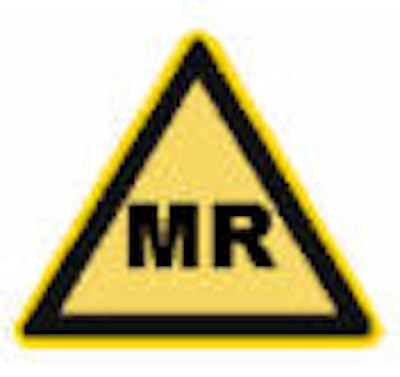
For years the U.S. Food and Drug Administration (FDA) has been struggling with a vocabulary problem. The current definition of "MR Safe" is limited to objects that don't get sucked into the bores of magnets. However, if a particular ladder, pump, or wheelchair is determined safe for a 0.35-tesla open MRI system, it isn't necessarily safe in a 3-tesla MRI, or even a 1.5-tesla system. And MR Safe may apply to certain gradients or sequences, but not others. MR Safe may have been deemed safe outside the 50-gauss line, but not inside it. In short, there is nothing definitive about an object being classified as MR Safe, which has led to tremendous confusion.
There's also nothing about the term MR Safe that leads you to believe that there are conditions attached. That and the seeming absoluteness of the term have led many to misuse the language. That's all about to change.
ASTM International (formerly the American Society for Testing and Materials, now known solely by their acronym), the body that developed the testing standards for the current MR Safe and MR Compatible, is now revising its language. The proposed new terminology has three classifications: MR Safe, MR Conditional, and MR Unsafe.
The proposed new language

Ultimately, objects or devices receiving the new MR Safe designation must be safe from RF heating, induced magnetic currents, rotational (torque) effects, or translational forces (missile effect).
According to Dr. Emanuel Kanal, who has worked with ASTM and the FDA to develop the new language and standards, "the only way an object with the proposed new MR Safe designation could hurt a patient (in an MR environment) would be if you threw it at them."
Objects getting the new designation will have to be fabricated very carefully from nonconductive materials such as rubber, plastics, ceramics, select polymers, wood, and fiberglass.
ASTM also proposes that vendors that can demonstrate that its products are made from accepted nonconductive materials will not have to undergo expensive testing and certification for the new MR Safe designation. No amount of scrutiny or testing will improve the MR safety of a rubber ball, so why squander the resources to do so?

Nearly everything that carries either the current MR Safe or MR Compatible designations would be switched to MR Conditional under the new standard. Operational criteria that currently are explained in the definition of MR Compatible would become conditions for use and function under the new MR Conditional label.

Additionally, the ASTM language eliminates any reference to magnet interference. This standard is to be exclusively about safety.
Currently, this is simply an ASTM proposed standard with no authority, but that won't last long. ASTM is developing this standard with the cooperation of the FDA; when completed, the agency will either reference the standard as is -- codifying the ASTM standard into the body of FDA regulations -- or use the ASTM language as a jumping-off point for its own standard.
Whatever road the FDA ultimately chooses, this revision holds the promise of making the language of MRI safety more coherent, logical, and intuitive, which can only serve to improve the application of safety principles.
In addition to identifying the safety of all objects that can be brought into the MRI suite, a proper MRI suite should also provide a secured quarantine area for MR Conditional and MR Unsafe items. If your facility doesn't have such an area, seek out expert advice to help you create one.
By Tobias Gilk
AuntMinnie.com contributing writer
October 27, 2005
Reprinted from www.mri-planning.com by permission of the authors. If you would like more information on any aspect of MR facility design or safety, please contact Robert Junk or Tobias Gilk at Jünk Architects.
Related Reading
Cost of MRI mishaps makes safety investment profitable, October 14, 2005
Interim trailer leasing: The hidden cost of MRI suite renovations, September 28, 2005
A shocking story of MRI static discharge, September 21, 2005
DI in the OR: The advent of intraoperative imaging, August 31, 2005
Modular done wrong: a $3 million barnacle, August 22, 2005
Copyright © 2005 Jünk Architects, PC


.fFmgij6Hin.png?auto=compress%2Cformat&fit=crop&h=100&q=70&w=100)





.fFmgij6Hin.png?auto=compress%2Cformat&fit=crop&h=167&q=70&w=250)











